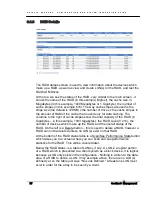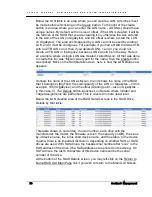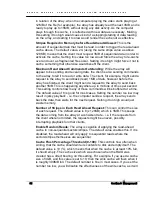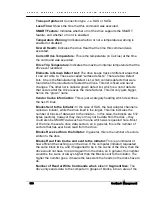
G A L A X Y ® A U R O U R A C O N F I G U R A T I O N A N D S Y S T E M I N T E G R A T I O N G U I D E
86
Section 3 Management
also be in the table. If there are entries before the screen we are looking at, a button at the
bottom will appear allowing you to see the “Previous 25 Trace Entries.” If there are entries
after the ones shown, you will see a button allowing you to see the “Next 25 Trace Entries.” If
you are somewhere in the middle, you will see both buttons, and if there are less than 25
entries, you will not see either button. Below these is a button which allows you to go to a
specific entry. When you do, it will show the list of 25 entries (if there are 25), starting at the
entry that you specified.
Below the Goto Entry button, is a button where you can toggle between the view of the
commands, and view of all. Simply click this button to toggle between the two.
The bottom button switches to a chart display, which
is
explained
below
.
The Return to NumaRAID GUI Main Page link at the bottom returns to the
NumaRAID GUI Main screen.
The Chart Display
, and example shown below,
shows a series of charts, graphing the
information shown in the Trace Details screen. For each chart, the horizontal axis is the entry
number. There are 10 charts in total. Note that the charts are showing 200 entries at any given
time, as opposed to 25 entries.
The top left chart shows the logical block address (LBA) or logical position number/sector
number within the RAID that the “virtual” head is positioned. In the example, it is a straight line
going up to the right, because it is the tail end of a sequential read. The vertical axis is the LBA
address.
The top right chart shows the transfer lengths. In my example, all of the lengths are 1024
bytes. The vertical axis is the transfer length.
The left chart in the second row indicates the access times to the cache in microseconds. The
vertical axis is the time.
The right chart in the second row indicates the time it took to execute the command in
microseconds. The vertical axis is the time.
The left chart in the third row shows data transfer rates. The vertical axis is in megabytes per
second.
The right chart in the third row shows the command transfer rates. The vertical axis is in
megabytes per second.
The left chart in the fourth row shows the write back cache usage. The vertical axis is number
of write backs.
The right chart in the fourth row shows read ahead cache usage. The vertical axis is the
number of read-aheads.
The left chart in the bottom row shows non-real-time commands. The vertical axis is the
number of commands.
The right chart in the bottom row shows write cache saturation. The vertical axis is the number
of dirty cache segments.
At the bottom of the graphs, similar to the data display, are two buttons: One allows you to go
to the previous 200 entries (if there are any). One allows you to go to the next 200 entries (if
there are any). Finally, there is a box you can type a number in, along with a GoTo button,
which allows you to display 200 entries starting with the entry number specified.
Below these is a button which allows you to switch back to the data/text display.






























